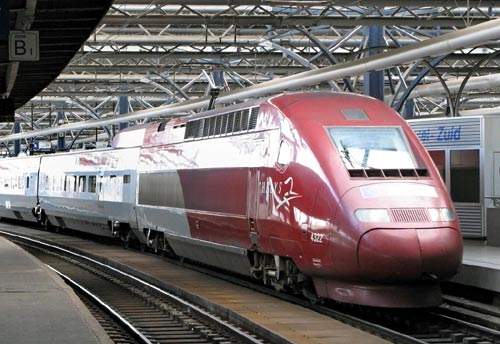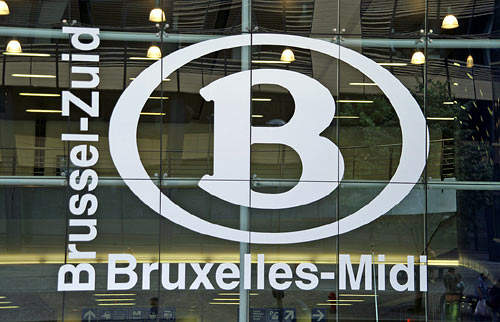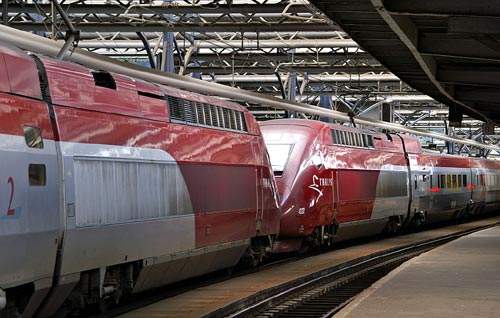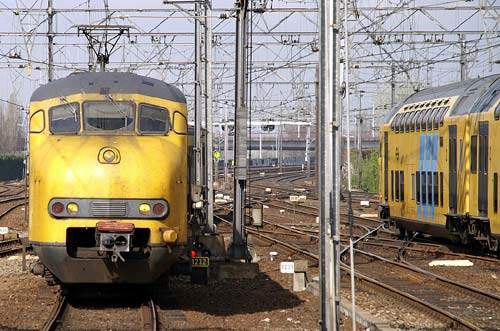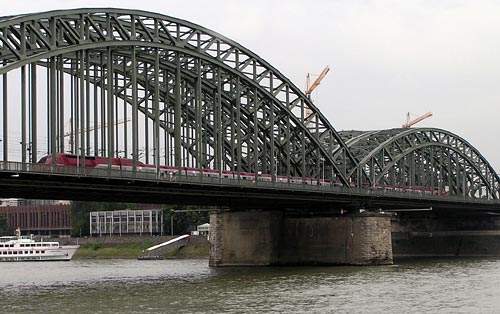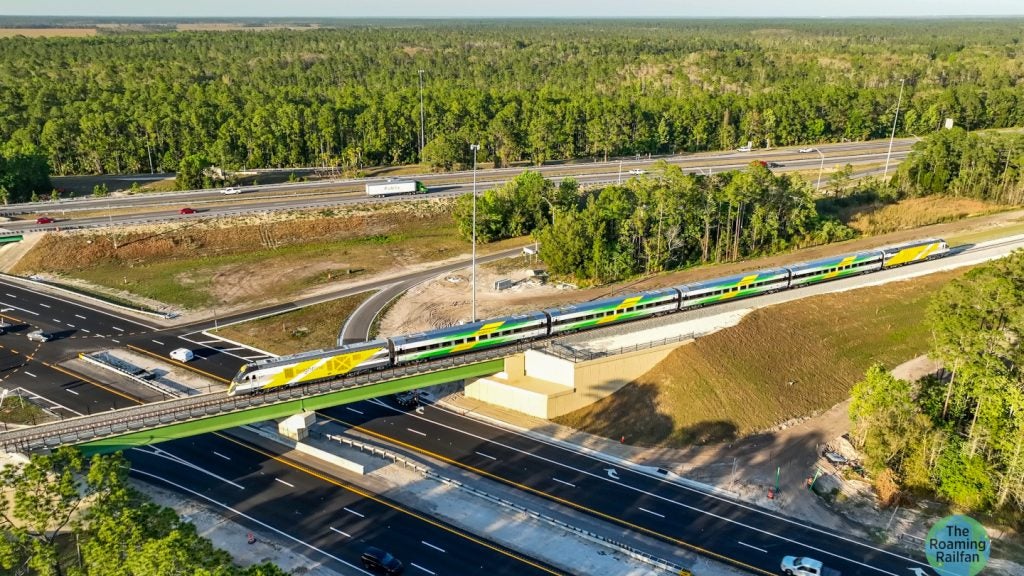Thalys is a cross-border, high-speed passenger service that centres on the Brussels Midi station, linking the Belgian capital to Amsterdam, Paris and Cologne among others. The service is offered jointly by the Belgian, French, Dutch and German railways.
The network began with the creation of Westrail International, a joint subsidiary of the SNCF and SNCB, set up in 1995 to create a high-speed network across the four countries. Westrail became Thalys International in November 1999.
The Paris-Brussels-Amsterdam line opened in 1996. A journey between Paris and Brussels took just over two hours; the first high-speed line opened in 1997, cutting travel time to 90 minutes.
The distinctive maroon, TGV-derived Thalys trains have become a familiar sight and distinctive brand in western European rail operations. The Thalys name has no specific meaning beyond the service itself; created for distinctiveness, yet without specific identification with any of the countries served.
With the gradual incorporation of more high-speed lines and the relatively short distances between the cities, Thalys and Eurostar, the other main international European rail brand, have been very successful in wresting market share from airlines, especially for business passengers. The centre-to-centre timings allow for return trips between key commercial centres within a day.
The project
With the completion of the 88km LGV Belge high-speed line, the centres of Paris and Brussels were brought within 90 minutes of each other by rail.
A high-speed line linking Brussels to Aachen, via Liège, was completed in late 2007. However, a lack of modern signalling equipment meant it was not used by high-speed trains until December 2009.
Although the very first Thalys services to Amsterdam began in 1996, delays in the commissioning of the new Dutch HSL Zuid (in English: high-speed line south) Antwerp-Rotterdam-Amsterdam line meant that the Thalys service didn’t begin until December 2009.
Regular Thalys services also operate between Brussels and Ostend, and through Belgium via the southern Namur-Charleroi-Mons route. Seasonal timetabling extends to the Alps and the south of France via the Paris Charles de Gaulle/Marne la Vallée line. Trains run hourly between Paris and Brussels, with many dividing there to serve Amsterdam and Cologne.
Infrastructure
Although Thalys was founded on the potential for reduced journey times opened up by the LGV Nord and the first Belgian high-speed line, subsequent developments have been more piecemeal. The Leuven-Liège section opened in 2003 and is used by Thalys trains, two-hourly ICE3 services from Germany to Belgium and, unusually for this type of line, certain conventional locomotive-hauled SNCB InterCity trains on the Ostend-Liège-Eupen route.
The 27km, 220km/h Liège-Aachen cut-off, high-speed section opened in 2007, with services beginning in 2009.
New engineering works included a 6km tunnel, as well as the rebuilding of the Eupen-Aachen section of the existing mainline for higher speeds. The Liège Guillemins station was also given a €200m overhaul, redesigned by celebrated architect Santiago Calatrava. It opened in June 2009.
Further reductions will be possible with the opening of the Liège-Welkenraedt high-speed line. This will be complemented over the German border by the completed quadrupling and upgrading the Aachen-Cologne “classic” line to 230km/h high-speed line standards east of Düren. Travel times between Paris and Cologne should be cut to around three hours.
The former double-track line to Brussels has been widened to four tracks and Liège-Aachen upgraded. The 33km Brussels-Leuven line was rebuilt for 200km/h operation and the 7km between Schaarbeek and Zaventem increased from three to four tracks, with a new pair of tracks laid to Leuven. Upgrading the Brussels-Antwerp section for 160km/h was completed in 2000.
Relative to improvements elsewhere, accelerating services on the northern arm of Thalys operations into the Netherlands proved to be problematic. An interim domestic service operating with locos and hauled stock services on HSL Zuid began in 2007; introduction of Thalys on this route was further delayed by a lack of compatible signal equipment for the trains. Although Antwerpen Centraal had been converted into a through the station by 2007, Thalys services have continued to serve the city at Berchem station only.
Rolling stock
Thalys operates a fleet of 27 TGV-based trains, all built by Alstom. There are 17 four-voltage trains designated PBKA (Paris-Brussels-Köln-Amsterdam), dating from the late 1990s. They mate new generation TGV Duplex style power cars with standard TGV articulated trailers.
In addition, ten second-generation tri-voltage TGV Réseau sets (with 25kV AC, 3kV DC and 1.5kV DC capability), called PBA (Paris-Brussels-Amsterdam) trains, were reallocated to the service from SNCF’s own fleet. As with other TGV trains, Thalys run at 300kmh. Each 200m-long set has 377 seats (120 of which are first class).
The Paris-Brussels Thalys service is the most intensive between two European capitals; there are 28 trains in each direction each day, one every half hour on weekdays.
Following a decade in service, a mid-life refurbishment programme was drawn up ahead of the Thalys sets being used on the new HSL Zuid line. SNCF’s Hellemmes works near Lille, France was chosen to carry out the refurbishment, which included fitting European Train Control System Level 2 signalling equipment for operating Thalys on HSL Zuid from 2008.
DB Class 406 ICE3M multi-voltage EMUs have linked Brussels with Cologne and Frankfurt several times a day since December 2002, replacing traditional locomotive-hauled international trains.
Plans to extend Paris Thalys services through to Frankfurt via the Cologne-Frankfurt high-speed line, which opened in December 2002, were shelved because TGV trains could not maintain 300km/h line speeds using 15kV AC on the steeply-graded route.
Signalling and communications
Belgium’s high-speed railways use the French TVM430 system, dispensing with the need for line-side signals. Train drivers receive information about the route ahead and the maximum speed they can run at from in-cab equipment. However, on classic routes standard line-side signalling is used.
Thalys PBKA use a mixture of new and classic routes, and are equipped to operate on seven different signalling systems on their journeys between Paris, Belgium, the Netherlands and Germany. To accommodate the use of Thalys sets on the new HSL Zuid line, all trains were fitted with European Train Control System Level 2 signalling equipment.
Consistent with its positioning relative to the business market and airline competition, Thalys places an emphasis on long-term customer engagement and repeat trade through its Cybelys membership and Lys Card schemes. Electronic ticketing and internet/telephone information systems feature prominently in their operation. Thalys was a founding partner in the Railteam consortium launched in 2007 to promote rail operations across the high-speed European network.
The future
Passenger growth has been spectacular since the opening of the LGV Nord-Europe and Belge high-speed lines.
With demand likely to increase when journey times reduce further, Thalys is considering increasing capacity. Ideas include double-deck TGV Duplex trailers, as used by SNCF, and greater service frequency.
The Thalys International partnership increased in 2007, with German operator DB taking a 10% share. The perceived quality of the overall service has been boosted by the rebuild of the Brussels Midi hub, with similar improvements apparent in Antwerpen and Liège.
With high levels of punctuality and customer satisfaction, and the proportion of its routes suitable for 300km/h operation to grow significantly in the near future, Thalys seems well positioned to build on its successes of the past decade.

